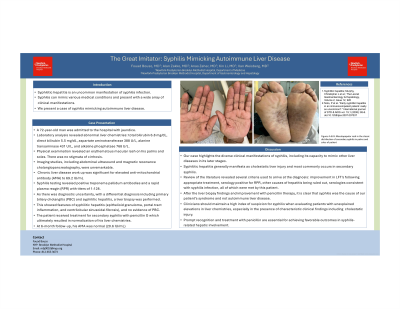Tuesday Poster Session
Category: Liver
P4855 - The Great Imitator: Syphilis Mimicking Autoimmune Liver Disease
Tuesday, October 29, 2024
10:30 AM - 4:00 PM ET
Location: Exhibit Hall E

Has Audio

Muhammad F. Bouso, MD, MS
New York-Presbyterian Brooklyn Methodist Hospital
Brooklyn, NY
Presenting Author(s)
Muhammad F. Bouso, MD, MS1, Alan Zakko, MD2, Anas Zaher, MD3, Kin Li, MD1, Ilan Weisberg, MD1
1New York-Presbyterian Brooklyn Methodist Hospital, Brooklyn, NY; 2New York-Presbyterian Brooklyn Methodist Hospital, New York, NY; 3New York-Presbyterian / Brooklyn Methodist Hospital, Brooklyn, NY
Introduction: Syphilitic hepatitis is an uncommon manifestation of syphilis infection. Known as the "great imitator," syphilis can mimic various medical conditions and present with a wide array of clinical manifestations. We present a case of syphilis mimicking autoimmune liver disease.
Case Description/Methods: A 72-year-old man was admitted to the hospital with jaundice. Laboratory analysis revealed abnormal liver chemistries including total bilirubin 6.8 mg/dL, direct bilirubin 5.5 mg/dL, aspartate aminotransferase 388 U/L, alanine transaminase 431 U/L, and alkaline phosphatase 768 U/L. Physical examination revealed an erythematous macular rash on his palms. Imaging studies, including abdominal ultrasound and magnetic resonance cholangiopancreatography, were unremarkable. A serologic evaluation for etiologies of chronic liver disease was significant for elevated anti-mitochondrial antibody (AMA) to 69.2 IU/mL. Given the physical exam findings, syphilis testing was also performed. This revealed a rapid plasma reagin (RPR) with titers of 1:128 and positive treponema pallidum antibodies. As there was diagnostic uncertainty, with a differential diagnosis including primary biliary cholangitis (PBC) and syphilitic hepatitis, a liver biopsy was performed. This showed features of syphilitic hepatitis and no evidence of PBC. The patient received treatment for syphilis with penicillin G which ultimately resulted in normalization of his liver chemistries. At 6-month follow-up, his AMA was normal.
Discussion: Our patient was diagnosed with syphilitic hepatitis after an extensive serologic and histopathological workup. The main clue to the diagnosis was the finding of a palmar rash, highlighting the importance of a thorough physical exam and history. Our case also demonstrates the continued need for histological analysis in patients with liver disease. While this patient met criteria for PBC, his older age and the presence of a rash led us to question this diagnosis. After the liver biopsy findings and improvement with penicillin therapy, it is clear that syphilis was the cause of our patient’s syndrome. Clinicians should maintain a high index of suspicion for syphilis in all patients with unexplained cholestatic patterns of liver injury, especially considering the rise in syphilis cases in the United States.
Disclosures:
Muhammad F. Bouso, MD, MS1, Alan Zakko, MD2, Anas Zaher, MD3, Kin Li, MD1, Ilan Weisberg, MD1. P4855 - The Great Imitator: Syphilis Mimicking Autoimmune Liver Disease, ACG 2024 Annual Scientific Meeting Abstracts. Philadelphia, PA: American College of Gastroenterology.
1New York-Presbyterian Brooklyn Methodist Hospital, Brooklyn, NY; 2New York-Presbyterian Brooklyn Methodist Hospital, New York, NY; 3New York-Presbyterian / Brooklyn Methodist Hospital, Brooklyn, NY
Introduction: Syphilitic hepatitis is an uncommon manifestation of syphilis infection. Known as the "great imitator," syphilis can mimic various medical conditions and present with a wide array of clinical manifestations. We present a case of syphilis mimicking autoimmune liver disease.
Case Description/Methods: A 72-year-old man was admitted to the hospital with jaundice. Laboratory analysis revealed abnormal liver chemistries including total bilirubin 6.8 mg/dL, direct bilirubin 5.5 mg/dL, aspartate aminotransferase 388 U/L, alanine transaminase 431 U/L, and alkaline phosphatase 768 U/L. Physical examination revealed an erythematous macular rash on his palms. Imaging studies, including abdominal ultrasound and magnetic resonance cholangiopancreatography, were unremarkable. A serologic evaluation for etiologies of chronic liver disease was significant for elevated anti-mitochondrial antibody (AMA) to 69.2 IU/mL. Given the physical exam findings, syphilis testing was also performed. This revealed a rapid plasma reagin (RPR) with titers of 1:128 and positive treponema pallidum antibodies. As there was diagnostic uncertainty, with a differential diagnosis including primary biliary cholangitis (PBC) and syphilitic hepatitis, a liver biopsy was performed. This showed features of syphilitic hepatitis and no evidence of PBC. The patient received treatment for syphilis with penicillin G which ultimately resulted in normalization of his liver chemistries. At 6-month follow-up, his AMA was normal.
Discussion: Our patient was diagnosed with syphilitic hepatitis after an extensive serologic and histopathological workup. The main clue to the diagnosis was the finding of a palmar rash, highlighting the importance of a thorough physical exam and history. Our case also demonstrates the continued need for histological analysis in patients with liver disease. While this patient met criteria for PBC, his older age and the presence of a rash led us to question this diagnosis. After the liver biopsy findings and improvement with penicillin therapy, it is clear that syphilis was the cause of our patient’s syndrome. Clinicians should maintain a high index of suspicion for syphilis in all patients with unexplained cholestatic patterns of liver injury, especially considering the rise in syphilis cases in the United States.
Disclosures:
Muhammad Bouso indicated no relevant financial relationships.
Alan Zakko indicated no relevant financial relationships.
Anas Zaher indicated no relevant financial relationships.
Kin Li indicated no relevant financial relationships.
Ilan Weisberg indicated no relevant financial relationships.
Muhammad F. Bouso, MD, MS1, Alan Zakko, MD2, Anas Zaher, MD3, Kin Li, MD1, Ilan Weisberg, MD1. P4855 - The Great Imitator: Syphilis Mimicking Autoimmune Liver Disease, ACG 2024 Annual Scientific Meeting Abstracts. Philadelphia, PA: American College of Gastroenterology.
